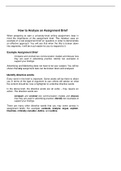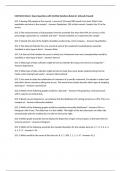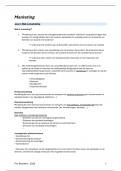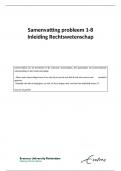,Exploring Strategy summary
Chapter 1 – introducing strategy
Definition of strategy: strategy is the long-term direction of an organization
Long term direction of the company can include both deliberate, logical strategy and more
incremental, emergent strategies. As well as, strategies that emphasize difference &
competition, and that recognize the roles of cooperation & imitation
Three horizons framework
Suggests organizations should think of themselves comprising three types of businesses or activity,
defined by their ‘horizons’ in terms of years
Horizon 1: current core activities:
- Need defending & extending
- Likely to decline in profit in the long
term Horizon 2: emerging activities:
- Should provide new sources of
profit Horizon 3: uncertain possibilities:
- Often risky research & development projects, or start-ups
Strategy: push out/ focus on horizon 1 as long as possible, while also working on horizon 2&3
3 main levels of strategy that can be found within an organization:
Corporate-level strategy deals with the organisation and its businesses as a whole and how added-
value can be created.
Business-level strategy focuses on the individual businesses and how they operate in their particular
market.
Functional strategies are concerned with the delivery of resources, processes and people to the
corporate- and business-level strategies.
An organisation´s strategy should be summarized in a strategy statement. This statement should
include the fundamental goals like mission, vision and objectives, the scope (customers, location,
internal activities) of the organisation’s activities and the (competitive) advantages or capabilities of an
organisation.
The “exploring strategy” framework
Includes understanding the strategic position of a company; assessing strategic choices for the future;
and managing strategy in action
1
, Strategic position: is concerned with the
impact of strategy on macro-environment,
the industry environment, the organization’s
strategic capability, stakeholder & company
culture
Strategic choices: involve the options for
strategy in terms of both the directions in
which the strategy might move and the
methods by which strategy might be pursued
Strategy in action: is about how strategies
are formed and implemented
Working with strategy
• strategy is a key issue for top management and concerns all levels of a business → working
has to be in coherence with the strategy
• the more convincing the strategy is communicated throughout the company, the better the
performance
• middle and lower-level managers play a growing part in shaping strategy themselves, since
they are closer to the actual operations
• private and public specialist strategists exist, since strategy consulting is a growth industry
3 main branches of strategy research
Strategy lenses
- distinct, theoretically informed perspectives on strategy
- ways of looking at strategy issues differently in order to generate additional insights
- can raise new ideas and solutions
2
, Strategy as design: This takes the view that strategy development can be designed in the abstracts. It
tends to exclude improvisation in strategy development and underplay the unpredictable. It means
evaluating hard facts while being objective, analytical and systematic.
Strategy as experience: This lens recognises that the future strategy of an organisation is often heavily
influenced by its experience and that of its managers. Strategy is likely to build on and continue what
has gone on before.
Strategy as variety: The variety lens sees strategy not so much as planned from the top, as emergent
from within and around organisations. New ideas bubble up through unpredictable and competitive
processes. The variety lens therefore emphasizes the importance of promoting diversity in and around
organisations.
Strategy as discourse: The discourse lens points to how command of strategy discourse becomes a
resource for managers. Treating strategy as a discourse focuses attention on the ways managers use
language to frame strategic problems. It includes use of language to formulate strategic problem,
making strategy proposals, debating issues communicating strategic decisions legitimacy
3














